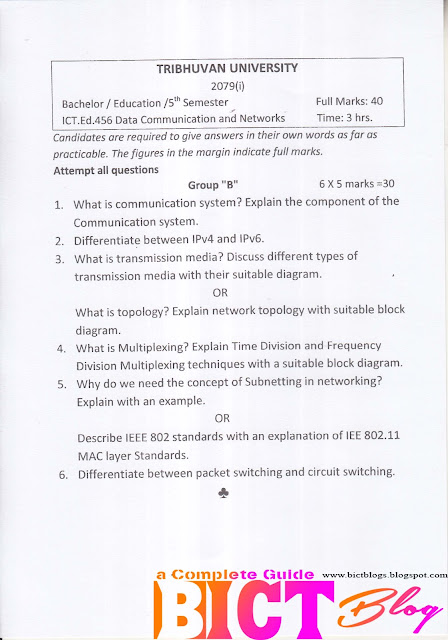Answer
1. The correct subnet mask for dividing the IP network 192.168.20.0 into 10 equal-sized subnets would be:
b. 255.255.255.254
2. The multiple access technique used by the IEEE 802.11 standard for wireless LAN is:
b. CSMA/CA
3. True statements with respect to TCP are:
d. All of the mentioned
4. The reason for using a firewall in the network layer is:
a. for Frame filter
5. The protocol that assists in providing remote login access over the network in the application layer of the TCP/IP reference model is:
d. Teletype Network Protocol (TELNET)
6. ICMP is used in the email service for:
a. error and diagnostic functions
7. The methods to move data through a network of links and switches are:
d. Packet switching and Circuit switching
8. The network topology that requires a multipoint connection is:
a. Star Topology
9. The command that displays RIP routing updates is:
b. Debug IP rip
10. The correct statement concerning Time Division Multiplexing (TDM) and its variants is:
a. TDM requires the transmitter and receiver to be synchronized periodically.
Answer
1. The number of error bits that occur for a given number of bits transmitted is called:
a. Bit error rate
2. The number of repeaters in a coaxial cable link is determined by:
d. System bandwidth
3. The device that receives the digital signal, recovers the pattern of 1s and 0s, and re-transmits a new signal is called:
a. Repeater
4. The layer responsible for removing the network layer header as the data unit moves to the transport layer is:
a. Data Link
5. The address used by the routing table in a switch is:
d. Destination
6. The algorithm that defines which network path or paths are allowed for each packet is known as:
c. Routing algorithm
7. The protocol of TCP/IP that exhibits its usability in applications requiring instant and essentially reliable delivery operations is:
a. Transmission Control Protocol (TCP)
8. The communication protocol used by the internet is:
c. TCP/IP
9. The natural mask for a class C Network is:
b. 255.255.255.0
10. IEEE 802 controls:
d. All of the above (Errors, Frames, Flow)
Answer
1. In which electromagnetic waves ranging in frequencies between 3 KHz and 1 GHz?
b. Radio waves
2. Which modulation is based on Frequency Shift Keying?
a. Amplitude Modulation
3. Which network device is used in analog transmission to achieve longer distances?
d. Amplifiers
4. Which layer establishes, maintains, and synchronizes the interaction between communicating systems?
a. Session
5. Which address in the header of a packet in a datagram network normally remains the same during the entire journey of the packet?
b. Destination
6. In which routing method is the routing path precomputed by the source, possibly by table lookup, and placed in the packet header?
c. Source routing
7. In which class is the following IPv4 address: 126.5.6.7 based?
b. Class B
8. Which protocol is used to get files from another computer on the internet by using:
c. FTP (File Transfer Protocol)
9. Which protocol assists in providing remote login access over the network, especially in an application layer of the TCP/IP reference model?
b. TELNET (Network Terminal Protocol)
10. Which standard defines the wireless LAN standard?
b. IEEE 802.11
Answer
1. The type of transmission impairment in which the signal loses strength due to the resistance of the transmission medium is:
a. Attenuation
2. Which multiplexing technique involves signals composed of light beams?
a. WDM (Wavelength Division Multiplexing)
3. Which color coding of cable is used to connect similar devices?
a. Straight Cable
4. Which is/are subcategories of Packet-switched networks?
a. Virtual-circuit networks and datagram networks
5. Which of the following is NOT a class of LAN?
a. Broadband
6. What type of connector is typically used to connect thin net (RG-58) coaxial cabling to a network interface card?
a. BNC
7. Which of the following is the loopback address?
b. 127.0.0.1
8. Which of the following transport layer protocols is connectionless?
a. UDP (User Datagram Protocol)
9. Which one of the following devices rebroadcasts the signals it receives after conditioning them for increased strength and clarity?
a. Repeater
10. Which of the IEEE 802 standards defines the technologies used to form and manage personal area networks?
a. 802.15



.jpg)
.jpg)




No comments:
Post a Comment